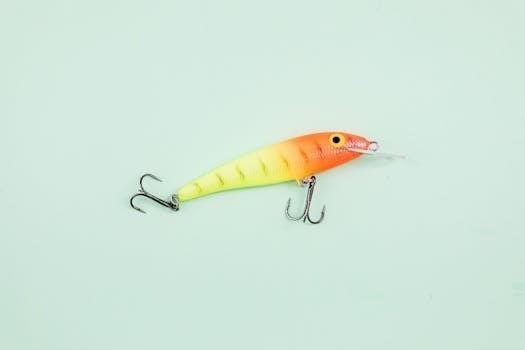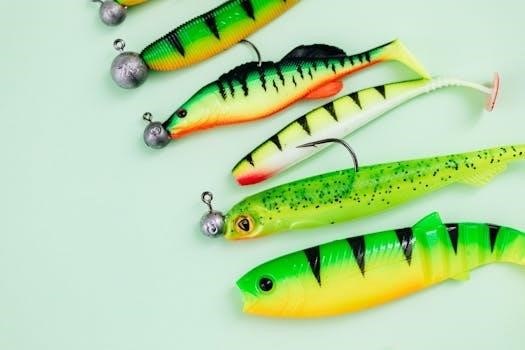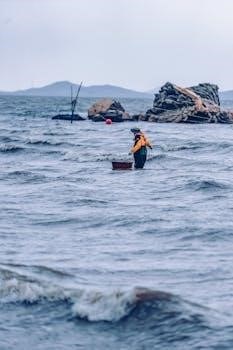
Saltwater fishing offers diverse experiences, from serene inshore flats to the mysterious deep ocean. Anglers target various species, using techniques like trolling and jigging, requiring a versatile skill set. Effective fishing involves understanding marine environments and adapting to different habitats.
Overview of Saltwater Fishing
Saltwater fishing is a captivating activity that spans a wide spectrum, from casual shore fishing to intense offshore expeditions. Beginners often start by targeting species like spotted seatrout and redfish in shallow waters, while seasoned anglers seek marlin or tuna in the deep sea. The choice of location and target species greatly influences the necessary gear and techniques. Saltwater fishing demands adaptability, as conditions can vary significantly due to tides, weather, and the specific marine environment. Mastery requires a blend of skill, knowledge, and patience. Understanding fish behavior and the ecosystem is crucial for success. The thrill of saltwater fishing comes from the challenge of the unpredictable ocean and the reward of reeling in a prized catch. Whether from a boat, shore, or pier, saltwater fishing provides unique adventures. It’s also important to practice responsible angling to ensure the health of marine ecosystems.

Essential Saltwater Fishing Gear
Selecting the right gear is crucial for success. This includes rods and reels designed for saltwater, appropriate baits, and effective hooks and rigs. Having the correct equipment enhances the fishing experience and improves catch rates.
Rods and Reels for Saltwater Fishing
Choosing the correct rod and reel is fundamental for saltwater fishing success. The best saltwater fishing rods often differ based on the target species, ranging from light tackle for inshore fish like spotted seatrout and redfish to heavy-duty rods for offshore giants such as marlin and tuna. Saltwater reels need to be corrosion-resistant and powerful, capable of handling the strong runs of ocean fish. For beginners, a medium action rod and a reliable spinning reel are good for general use. Experienced anglers may have specialized setups, including baitcasting reels for more control. Consider the line capacity and drag system of the reel to match the expected size of the fish. Always maintain your equipment by rinsing with fresh water after each use to remove salt and ensure its longevity. Understanding the nuances of your rod and reel will greatly enhance your fishing experience.
Best Baits for Saltwater Fishing
Selecting the right bait is crucial for successful saltwater fishing, and often, the best options are those that mimic the natural diet of the target species. Live bait such as shrimp and baitfish, offer consistent results. Shrimp are a favorite meal for many saltwater fish, making them effective when fishing from various locations, including bridges, piers, and boats. Different sizes of shrimp can attract varying sizes of fish. Natural baits provide the best opportunity for action. It’s beneficial to research the specific diet of the fish you’re pursuing. Lures, including jigs, soft plastics and spoons, can also be effective. Matching your bait or lure to the prevalent food sources in the area will increase your chances of a successful catch. Always keep live bait in a covered bucket or livewell. Consider using scented lures to further attract fish.
Saltwater Fishing Hooks and Rigs
Choosing the right hooks and rigs is essential for effective saltwater fishing. Circle hooks are often recommended, as they hook fish as they grab or swallow the bait. For surf fishing, the Carolina rig, also known as the C-Rig, is versatile and effective. This rig has been a staple in both freshwater and saltwater fishing due to its simplicity. It’s crucial to use a weighted rig with natural bait, like shrimp, to target a variety of species on the bottom. The Palomar knot is a fast, easy, and strong knot, suitable for braid, fluorocarbon, and monofilament lines. Different rigs are used for various species and locations, so it’s important to familiarize yourself with them. Always be prepared with a dehooking tool and line cutters for safety and efficiency. Mastering rig tying enhances your fishing experience.

Finding the Right Saltwater Fishing Spot
Identifying productive saltwater fishing spots requires understanding local waters. Beginners might start at public piers, while experienced anglers explore diverse habitats. Researching the natural diet of target species helps identify prime areas and effective bait choices.
Understanding Tides and Their Impact on Fishing
Tides play a crucial role in saltwater fishing, influencing fish behavior and feeding patterns. Rising tides often bring in baitfish and predatory species, creating feeding frenzies. Conversely, falling tides can concentrate fish in specific areas, making them easier to target. Understanding local tide charts is essential for planning successful fishing trips. High tide periods often provide access to shallow areas, while low tide can expose structures where fish congregate. Tidal currents affect the movement of bait and lures, requiring anglers to adjust their techniques. Paying close attention to tidal shifts and their impact on specific fishing spots is key to improving catch rates. The movement of water during tides can also influence water clarity and temperature, impacting fish activity. Experienced anglers use their knowledge of tides to anticipate where fish will be most active, maximizing their chances of success. Effective use of tide charts enhances saltwater fishing experiences.

Saltwater Fishing Techniques
Mastering diverse techniques is vital for saltwater fishing success. Trolling, jigging, surf fishing, and sight fishing are effective methods. Each technique requires specific gear and adaptations to various conditions and fish behavior.
Trolling for Saltwater Fish
Trolling is a highly productive saltwater fishing technique that involves dragging baited hooks or lures behind a slow-moving boat. This method simulates swimming bait schools, attracting various species like marlin, mahi-mahi, and wahoo. Anglers typically use multiple rods simultaneously, increasing their chances of a hookup. Trolling can be effective in both shallow and deep waters, making it a versatile approach for different fishing environments. The key is to adjust speed and lure presentation to match the target species and their feeding habits. Successful trolling often involves understanding the local currents and baitfish patterns. This technique allows anglers to cover a significant amount of water, enhancing their opportunity to encounter active fish. Moreover, trolling can be very effective with both live and artificial baits.
Jigging in Saltwater
Jigging is a dynamic saltwater fishing technique that involves rapidly moving a lure or jig vertically through the water column. This method is particularly effective for targeting fish that reside near the bottom or in deeper waters. Anglers use a variety of jigs, often with soft plastic trailers, to entice strikes from species like cobia, tuna, and stripers. Deep-water jigging requires specialized gear and techniques to effectively work the lure at various depths. The key to success with jigging is mastering the proper presentation and action of the jig, often involving a combination of lifts, drops, and pauses. This technique demands active participation from the angler, requiring constant attention to the lure’s movement. Jigging can be highly rewarding, especially when targeting aggressive predatory fish that respond well to vertical presentations.
Surf Fishing Techniques and Rigs
Surf fishing involves casting from the shoreline into the surf zone, targeting fish that patrol the sandy bottoms and crashing waves. This method often requires specialized techniques and rigs to maximize effectiveness. The Carolina rig, known for its simplicity and versatility, is a popular choice for surf fishing due to its ability to present bait naturally. Anglers often use weighted rigs with natural baits like shrimp to catch a variety of species near the bottom. Mastering casting techniques to reach the desired distance is crucial, as is understanding wave patterns and currents. Successful surf fishing relies on proper bait presentation, patient observation, and adaptability to changing conditions. It’s important to select the right hook size and type for the specific species targeted and always have dehooking tools and line cutters readily available.
Inshore Saltwater Fishing Methods
Inshore saltwater fishing encompasses a wide array of techniques, targeting species in bays, estuaries, and shallow coastal waters. It often involves casting near structures such as docks, mangroves, or oyster beds where fish seek refuge and food. Anglers use a variety of methods, including live bait fishing with shrimp or baitfish, and lure fishing with soft plastics and spoons. Adjusting retrieval speed is key to enticing strikes. Successful inshore fishing requires knowledge of the local environment, including areas where specific species congregate. Understanding tides and their impact on fish behavior is crucial for success. Additionally, choosing the right tackle, including specialized baitcasting reels, is essential for effective inshore fishing. Patience and observation are key, as well as being ready to adapt to changing conditions.
Sight Fishing on the Flats
Sight fishing on the flats is an iconic method that relies heavily on observation. Anglers actively search for target fish in shallow, clear waters, often using polarized sunglasses to reduce glare and enhance visibility. This technique involves stalking fish, either by spotting them visually or observing their wakes or feeding patterns. Once a target is identified, a precise cast is made, often with a fly or light lure. Patience and stealth are critical to avoid spooking the fish. Effective sight fishing requires a deep understanding of fish behavior and the ability to recognize subtle signs of their presence. It’s a challenging yet rewarding method that emphasizes skill and observation.

Saltwater Fishing Tips and Best Practices
Safety is paramount when saltwater fishing, requiring awareness of weather and water conditions. Practicing good fishing etiquette and conservation helps maintain healthy fish populations, ensuring a sustainable fishing future for all.
Safety Considerations When Saltwater Fishing
Prioritizing safety is crucial for every saltwater fishing trip. Always check weather forecasts before heading out, being mindful of changing conditions. Wear appropriate clothing, including sun protection like hats and sunscreen, to prevent overexposure. It’s essential to have a first-aid kit onboard for minor injuries. When fishing from a boat, ensure all safety equipment is present and functioning, including life jackets. Be aware of the tides and currents, which can be unpredictable. Always inform someone of your fishing plans, including your expected return time. A dehooking tool and line cutters should be readily available for safe handling of fish. Be mindful of slippery surfaces and sharp objects. By taking these safety precautions, anglers can enjoy their fishing adventures with confidence and reduce risks.
Saltwater Fishing Etiquette and Conservation
Practicing good etiquette and conservation is vital for the sustainability of saltwater fishing. Respect other anglers’ space and avoid crowding popular fishing spots. Always dispose of trash properly and never throw fishing line or plastic into the water. Be mindful of noise levels, especially in sensitive areas. Adhere to all fishing regulations, including catch limits and size restrictions. Consider practicing catch and release to help maintain fish populations. Handle fish carefully and use dehooking tools to minimize harm. Support marine conservation efforts and participate in habitat restoration projects. Avoid disturbing wildlife and their natural habitats. By following these guidelines, anglers can enjoy fishing while protecting marine ecosystems for future generations. Being responsible stewards ensures the longevity of the sport and the health of our oceans.